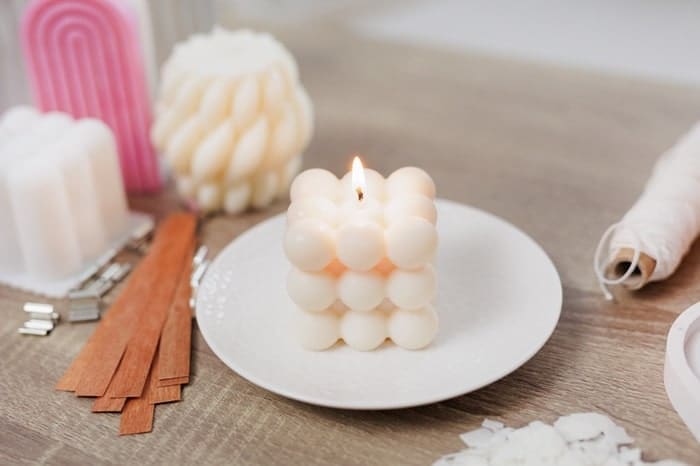Crafting candles involves more than simply pouring wax into a mold. The shape and size of custom candle molds directly affect a candle’s burn time and overall wax performance. Custom molds can significantly impact how evenly a candle burns and how its fragrance is released.
Certain designs of custom candle molds allow for a more consistent burn. For instance, molds tailored to a particular blend of waxes control heat distribution, preventing problems like tunneling. Candlemakers interested in unique designs and branding can find custom candle molds here. These molds also influence the scent throw, which is important for creating a pleasing ambiance.
The candle making process can be enhanced with the right mold that ignites creativity alongside functionality. To achieve your desired outcome, factors such as wax type, wick size, and even your chosen mold should work in harmony. Candle makers can beautify their creations while being efficient by understanding these dynamics.
Impact of Mold Design on Burn Time
Candle molds play a significant role in determining how a candle burns. The material of the mold, its shape and size, and the placement of the wick in relation to the mold structure all influence the burn time.
Influence of Mold Material
The material selected for the development of candle molds affects the heat retention properties and, as a result, the candle’s burn time. Most people prefer silicone molds since they are supple and heat resistant. They allow for uniform heat flow which guarantees reliability in the rate of burning and easy removal.
Metal molds cool off rapidly and can contribute to uneven candle burning if the candle is not removed immediately after setting. This can increase the rate at which wax is consumed as compared to other materials. Accordingly, the type of mold used will determine the length of time the candle can burn.
Shape and Size Considerations
A candle’s mold has significant effects on the rate at which it burns. Greater size casts usually have an increased amount of wax which results in longer burn times. For example, tall cylindrical molds are known to create candles that can burn for a considerably long time owing to the abundance of wax they possess.
On the contrary, wide and shallow molds might produce candles that burn quicker, as more wax is exposed to heat at once. The shape should be carefully considered based on the desired burn duration and wax type. Larger candles usually have longer burn times due to increased wax volume.
Wick Placement and Mold Structure
Correct wick positioning contributes to an even burn and, hence, enhances the quality of a candle. If the wick is off-center, even by a bit, it will result in tunneling and wasting wax. The mold must facilitate proper wick alignment.
Rigids with integrated wick holders easily assist in wicked molds, ensuring the wick maintains the right alignment without distortion. These molds maximize burn time and improve overall candle quality. Precise manual adjustment of the wick is necessary for molds without guides to eliminate inefficient burning.
Effects on Wax Performance
Different candle shapes contain varying wax qualities, which affect burning efficiency and aesthetic appeal. Candlemakers should pay attention to wax interaction with diverse mold shapes, as custom candle molds greatly impact wax behavior during burning.
Wax Type Compatibility with Molds
Different waxes perform uniquely depending on the mold used. For instance, soy wax, known for its even burning and long-lasting properties, may interact optimally with silicone molds. Silicone molds provide flexibility, reducing the risk of cracking. In contrast, paraffin wax may be suitable for metal molds, which offer sturdiness and heat retention.
Additionally, mold material influences the release of the candle. Beeswax responds better to specific mold types by promoting a secure release and consistent finish. Choosing the right mold that aligns with the wax type is important for achieving optimal wax performance.
Temperature Regulation During Burning
The burning characteristics of wax are highly affected by the composition of the mold materials due to them having varying thermal conductivities. Metal molds conduct and retain heat. Thus, wax tends to burn at a constant rate, which results in a consistent, steady melt pool. While burning, the wax consumes the oxygen in the mold efficiently. Silicone molds, on the opposite, greatly lose heat, which affects the stability of wax.
A wax burn is considered covertly inefficient if, due to temperature, it tunnels. Balancing the thermal retention characteristics of a mold together with the type of wax used helps target the desired temperature to improve performance and efficiency while elevating burn quality.
Release Properties and Finish Quality
Release properties of custom molds impact the final surface quality of the candle and its appearance. Defect free release from the mold is smooth ensures the candle has no surface imperfections. Smooth finishing is further aided by silicone molds owing to their non-stick properties.
Moreover, the surface finish of the candle highly depends on the material and the cleanliness of the mold. Dirty molds with excess granular material can have adverse effects by blocking and marring the surface finishing of the wax. A smooth release is vital which is why molds need to be clean and without any edges to improve finishing quality.
To recapitulate, custom design candle molds selection tremendously affects the wax’s performance and the aesthetic features of the candle.
Conclusion
As noted in this guide, ranges of custom candle molds determine how a candle is burned, how much wax is consumed during the process, and even the aroma released throughout. The selection of mold material, as well as shape and size, can directly impact the final product of the candle. The consideration of a mold’s effect on heat circulation, wick position, and type of wax used is critical to the final output of our product, which needs to be an effective and efficient candle. The understanding of how a mold affects the way wax behaves is critical as it results in a candle that offers an elegant appearance while being durable.
Making custom molds offers an appealing opportunity for branding, which is great for personal marketing and custom-tailored wax performance alongside perfect burn features. Custom designed molds enable candle makers to set optimum parameters distinctive to their needs. Every passionate individual in the world of candle crafting needs these custom-designed molds in light of the proper tools and knowledge set outlines for achievable ideal burn results.


